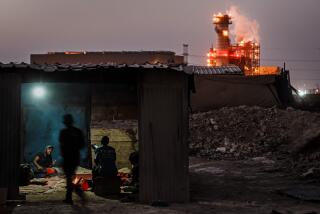Securing the ‘No-Camel’ Zone
- Share via
JAHRA, Kuwait — Shaypul Islam is going on a 50-mile trip and he is taking a whole herd of his friends with him.
After leaving the traditional foraging area north of Kuwait City, Islam and his camels will walk from what has become a “military exclusion area” to a region, four days away, that will be out of harm’s way in the event of war.
Camel herders -- some of whom are unaware that war is brewing between the U.S. and Iraq -- have been given until Saturday to move thousands of camels or face fines and the loss of their valuable animals.
U.S. and Kuwaiti officials are worried about the possibility of deadly collisions between camels and the convoys of vehicles bound for a growing number of military camps. Already, two Army Humvees have collided when they tried to avoid hitting a camel in the road.
The herders complain that the zone to which they are being exiled does not have as much vegetation as the usual grazing area. That will force them to supplement the camels’ diet with feed, cutting into profits.
“There is no grass there,” said Shafi Bahar, a Kuwaiti Bedouin who tends his herd from a Toyota Land Cruiser.
“They told us to move our camels, but no one will pay us” for the feed, said Islam, a Bangladeshi.
His coherder, Shar Zahad, shook his head in agreement. “It’s a problem,” he said. The pair are each paid the equivalent of about $125 a month to watch the camels 24 hours a day for the herd’s owner.
For herders like Islam who cannot afford a truck, the forced move means days of walking beside often unruly animals. The path to the safe haven parallels a busy highway, and the camels, if left untended, wander in front of speeding vehicles.
Sheep and goats are also being expelled from the area. Many are loaded into trucks for the relocation, a strategy that won’t work for the camels, which stand 6 feet tall and weigh 1,500 pounds.
The road is particularly dangerous because camels are notoriously stubborn and unwilling to move when a vehicle approaches. In recent years collisions between camels and cars have resulted in several deaths here.
Camel herding requires stamina and high tolerance for frustration. “This job is very hectic. I’m running all the time,” said Awad Din, a Bangladeshi.
As Din was talking, one of his camels was nearly struck by a late-model Lexus driven by a Kuwaiti woman. Irate, the woman stopped and scolded Din vigorously and then returned with two Kuwaiti police officers.
The officers helped Din move his camels away from the road by hurling rocks at the bawling beasts. The Lexus roared off .
“I do not like this job,” said Din as he continued his journey past a Kuwaiti military post and the U.S. Marine Corps settlement on his way to the foraging area near Sulaibiya.
Although they have been replaced by four-wheel-drive vehicles as the principal mode of desert transportation, camels are still used for meat and for racing. Some Kuwaiti families keep herds as a kind of status symbol.
The glamour of the dromedaries is lost on the herders, even those for whom herding is a family tradition.
“If I did not work with camels, I would not miss them,” Islam said.
More to Read
Sign up for Essential California
The most important California stories and recommendations in your inbox every morning.
You may occasionally receive promotional content from the Los Angeles Times.













